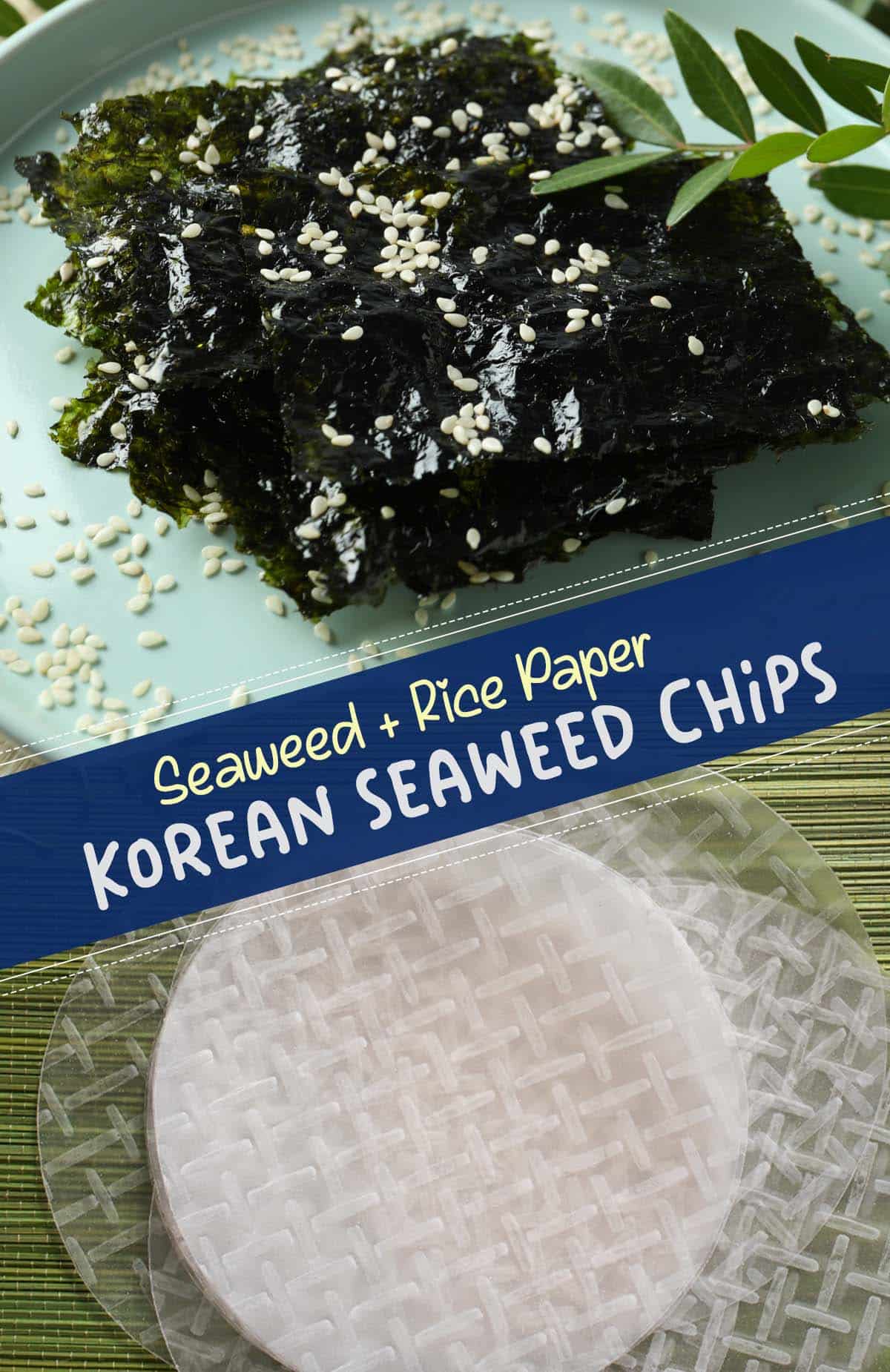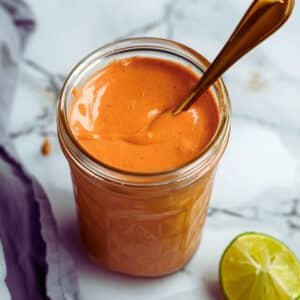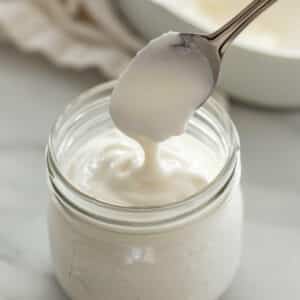I would be thrilled to introduce you to homemade seaweed chips or Nori snacks with rice paper, the food enthusiast I am! Trust me, once you've tasted these crispy, umami-rich morsels, you'll wonder how you lived without them. Not only do these delicious snacks offer a healthier alternative to traditional potato chips, but they're also a delightful combination of delicate rice paper and nutrient-packed seaweed.
So come on, let's roll up our sleeves and explore the endless possibilities of flavors and textures in the fantastic world of homemade seaweed chips! This article shares my experience in making sea weed chips with rice paper. I'll show you how simple creating this Korean seaweed snack is.
Take Aways
- Soak rice paper just enough: Be careful not to over-soak it, as it should only be moistened enough to become pliable, ensuring a good texture in the final chips.
- Be patient during drying: Allow the rice paper to fully dry on the seaweed sheets before cutting and frying. This step is essential for achieving the desired crispiness in the final product.
- Monitor oil temperature: Pay close attention to the oil temperature while frying (aim for 300-350°F), as it will affect the chips' taste and texture.
Jump to:

Ingredients you'll need:
- 4 sheets of roasted seaweed (Nori sheets)
- 4 sheets of rice paper
- 1 cup avocado oil or any neutral-tasting oil
- Warm water for wetting rice paper
- ¼ teaspoon sea salt (or table salt); adjust as needed
- ½ teaspoon toasted sesame seeds
Step-by-step instructions:
Step 1
Place a sheet of roasted seaweed on a clean work surface, with the coarse side facing up.
Step 2
Dip the rice paper briefly in warm water to wet it, then remove it immediately (avoid soaking too long).
Step 3
Promptly position it over the seaweed sheet. Press down on the rice paper to adhere it to the seaweed. Tuck in the corners of the unoccupied seaweed and fold in the edges of the protruding rice paper.
Step 4
Move the combined sheets to a cooling rack to dry while you continue with the remaining pieces.
Step 5
Allow the rice paper to dry until it's no longer sticky to the touch. This may take a while. Tip: Use a hair dryer or heat gun on the highest setting to speed up drying.
Step 6
With clean kitchen scissors, cut each combined sheet into equally-sized triangles.
Step 7
Heat avocado oil over medium heat. Once the oil is hot enough (check for bubbles by inserting a wooden chopstick), carefully fry the triangles rice paper side down until they become crispy, white, and exhibit a light brown tint, for about 10-15 seconds. Avoid over-frying until dark brown, which will result in a burnt taste.
Extra Tips:
- Fry at a moderate oil temperature, around 300-350°F, which makes the process more manageable. Avoid deep frying at medium-high heat settings.
- When deep frying, ensure the side containing rice paper is submerged in the oil. This allows it to develop a crispy texture as it bubbles and cracks. Neglecting this step may lead to a chewy texture instead.
- Be sure to allow the chips to remove excess oil after cooking. Too much residual oil can lead to a less crispy, soggy texture.
- Sprinkling a bit of salt according to your preference and some sesame seeds will enhance the snack's taste, providing additional flavor.
Step 8
Remove the chips from the oil and place them on a cooling rack to drain any excess oil (too much oil can make the chips soggy). Immediately sprinkle with salt according to your preference, and add sesame seeds.
Can you make Nori chips using an air fryer?
Absolutely! Although they won't develop the crackly or bubbly texture, they'll still be crispy and even healthier! Follow these steps:
Step 1
Begin by placing a sheet of roasted seaweed on a clean work surface.
Step 2
Dip the rice paper in warm water just long enough to moisten it, then place it on the roasted seaweed. Press down until the rice paper adheres to the seaweed, folding any excess seaweed or rice paper inwards.
Step 3
While the rice paper remains damp, evenly distribute a pinch of salt and sesame seeds over the sheet.
Step 4
Allow the rice paper to dry, or use a blow dryer until it's no longer sticky. Utilize a sharp knife or scissors to cut the sheet into triangular pieces.
Step 5
Arrange the triangles flat in the air fryer basket without overlapping them. Lightly mist the chips with oil. Position a wire rack that fits your air fryer basket on top of the chips to keep them from flying around and coming into contact with the heating element.
Step 6
Air fry at 350°F for 3 minutes or until crispy.
Ways to repurpose leftover seaweed sheets:
Leftover roasted seaweed sheets can be put to good use in various ways. Here are some ideas to help you make the most of them:
- Sushi rolls: Use the seaweed sheets to create your favorite sushi bake by filling them with rice, vegetables, and your choice of protein, such as fish, tofu, or cooked shrimp.
- Rice balls (Onigiri): Fill roasted seaweed sheets with seasoned rice and your preferred filling, such as tuna, salmon, or pickled vegetables, to make delicious Japanese rice balls.
- Wraps: Create healthy wraps using seaweed sheets as a low-carb alternative to tortillas or bread. Fill them with your favorite ingredients like cooked meats, avocado, or veggies.
- Snack: Enjoy the roasted seaweed sheets as a standalone snack, or add your favorite seasonings like salt, sesame seeds, or spices for extra flavor.
- Garnish: Crumble the roasted seaweed sheets over salads, rice bowls, or soups for added texture and flavor.
- Seaweed salad: Combine leftover seaweed sheets with other seaweed types, such as wakame or dulse, and toss them in a light dressing to create a nutritious seaweed salad.
- Breakfast bowls: Add crumbled roasted seaweed to breakfast bowls, such as quinoa or oatmeal, to boost flavor and nutrients. Check my Seafood loaded baked potato recipe here.
- Stir-fries: Incorporate roasted seaweed into your favorite stir-fry dishes for a unique flavor twist.
- Egg dishes: Use the seaweed sheets to wrap around scrambled eggs or omelettes, or chop them up and mix them into your egg dishes for added taste and nutrition. Egg in a hole recipe.
Recipe variations and flavor ideas
Consider these flavor combinations when creating your own. Experimenting with different seasonings and flavors when making seaweed and rice paper chips is fun.
Here are some recipe variations and flavor ideas to customize and elevate your Korean-inspired seaweed and rice paper chips:
1 Spicy Version:
Before frying, add a sprinkle of red pepper flakes, cayenne pepper, or a drizzle of sriracha sauce to give your chips a spicy kick.
2 Wasabi Flavor:
Mix wasabi powder with a bit of water to create a paste, then lightly brush it onto the seaweed before combining it with the rice paper for a tangy, sinus-clearing twist.
3 Teriyaki Twist:
Brush a thin layer of teriyaki sauce on the seaweed before adding rice paper for a sweet and savory combination.
4 Cheesy Seaweed Chips:
Lightly dust the chips with nutritional yeast or grated Parmesan cheese after frying for a cheesy flavor.
5 Garlic and Herbs:
Add a pinch of garlic powder and your choice of dried herbs (such as parsley, basil, or oregano) to the salt and sesame seed mixture for a savory, aromatic touch.
6 Sweet and salty:
Combine a small amount of brown sugar or maple syrup with the salt and sesame seed mixture to create a sweet and salty flavor profile.
7 Curry Flavored:
Mix a small amount of curry powder with the salt and sesame seed mixture for an Indian-inspired twist on your seaweed chips.
8 Lime and Chili:
After frying, sprinkle the chips with lime zest, chili powder, and salt for a tangy and spicy twist.
9 Everything Bagel Seasoning:
Replace the salt and sesame seed mixture with store-bought or homemade everything bagel seasoning blends for a familiar and delicious taste.
10 Sesame Soy:
Brush the chips with soy sauce and sesame oil before frying, then sprinkle with additional sesame seeds for an umami-rich flavor.
Begin with the roasted seaweed's rough side up.
Start with placing the roasted seaweed on your work surface, the rough side facing up. Avoid soaking the rice paper before getting your seaweed sheet ready, as this can lead to over-soaked and mushy rice paper that becomes hard to manage.
Having the rough side of the seaweed facing up ensures better adhesion between the rice paper and the seaweed sheet, making the process smoother.
Avoid overlaps for perfectly crispy seaweed chips.
In case there are any unattached edges of seaweed or rice paper, fold them inwards. Numerous recipes may suggest cutting the rice paper into quarters to match the size of your nori, but this can be quite fussy and lead to overlapping layers. Overlapping may result in thicker chips that can become overly chewy if they're not fried adequately.
The perfect rice paper soak
Dip the rice paper into warm water only until it becomes moistened—avoid soaking it for too long. Excessive soaking will make the rice paper overly soft and pliable, creating difficulty attaching it to the seaweed sheet.
Pairing suggestions
Seaweed and rice paper chips are versatile and pair well with various dips, sauces, and beverages. Here are some pairing suggestions to elevate your snacking experience:
Dips and sauces:
- Soy Sauce Dip: Mix soy sauce with a bit of rice vinegar, minced garlic, and a touch of sesame oil for a savory dipping sauce.
- Spicy Mayo: Combine mayonnaise with sriracha or another hot sauce for a creamy, spicy dip.
- Sweet Chili Sauce: Use a store-bought or homemade sweet chili sauce for a tangy and mildly spicy dip.
- Miso Hummus: Blend traditional hummus with white miso paste for a unique, umami-rich flavor.
- Creamy Avocado Dip: Blend ripe avocados with Greek yogurt, lime juice, garlic, salt, and pepper for a smooth, creamy dip.
- Ginger Scallion Sauce: Mix finely chopped scallions, grated ginger, soy sauce, and a touch of sesame oil for a fresh and zesty dipping sauce.
- Peanut Dipping Sauce: Whisk together peanut butter, soy sauce, lime juice, honey, and a bit of warm water for a creamy, nutty dip.
Storing for freshness and crispiness
To maintain the freshness and crispiness of your seaweed and rice paper chips, follow these storage tips:
- Cool completely: Before storing the chips, allow them to cool completely on a cooling rack. Storing warm chips can cause condensation, which leads to sogginess.
- Airtight container: Transfer the cooled chips to an airtight container or resealable plastic bag. Squeeze out as much air as possible before sealing to minimize moisture and preserve crispiness.
- Add a desiccant: To help absorb any excess moisture, place a food-safe desiccant packet (such as silica gel) in the container or bag with the chips. Alternatively, you can use a folded paper towel or a piece of bread to absorb moisture.
- Store in a cool, dry place: Keep the container or bag in a cool, dry place away from direct sunlight and heat sources. Avoid storing the chips in damp or humid areas, as moisture can seep into the container and cause them to lose their crispiness.
- Avoid frequent opening: Minimize opening the container or bag to prevent exposing the chips to air and moisture. If you plan to snack on the chips throughout the day, consider transferring a portion to a smaller container to maintain the freshness of the remaining chips.
How long do the homemade seaweed chips last?
Note that the chips may lose their crispiness over time. When stored properly, homemade seaweed and rice paper chips can last up to a week. To maintain their freshness and crispiness, follow the storage tips mentioned earlier:
- Cool the chips completely.
- Add a desiccant or a folded paper towel to absorb excess moisture.
- Keep the container in a cool, dry place away from direct sunlight and heat sources.
- Minimize opening the container to prevent exposure to air and moisture. Store in an airtight container or resealable plastic bag.
Note:
To enjoy your seaweed and rice paper chips for up to a week while maintaining their freshness and crispiness, store them properly. In case the chips lose their crunch, you can revive them by briefly baking them in a preheated oven at a low temperature (around 250°F or 120°C) for a few minutes. Afterward, let them cool completely before savoring the renewed crunch.
Pro tips for flavorful, crispy seaweed chip delights
1 Choose high-quality seaweed:
Opt for organic, sustainably harvested sheets for better flavor and nutritional value. High-quality seaweed sheets are less likely to break or crumble during the process.
2 Don't over-soak rice paper:
Soak rice paper just until it's moistened. Over-soaking can make it too soft and difficult to handle, leading to an unpleasant texture in the final product.
3 Use a clean, flat work surface:
Ensure your work surface is clean and flat to make the process of pressing the rice paper onto the seaweed sheets easier and more efficient.
4 Be patient while drying
Allow the rice paper to dry on the seaweed sheets before cutting and frying fully. This helps achieve the desired crispiness in the final chips. Using a blow dryer can speed up the drying process.
5 Monitor oil temperature:
Keep an eye on the oil temperature when frying the seaweed chips. Too high or too low a temperature can affect the texture and taste of the chips. Aim for a temperature between 300-350°F.
6 Drain excess oil
After frying, place the chips on a cooling rack or paper towels to drain any residual oil. This will help maintain their crispiness and prevent them from becoming soggy.
7 Seasoning and storage
Experiment with different seasonings like garlic powder, onion powder, or chili flakes to add variety to your homemade seaweed chips. Store the chips in an airtight container at room temperature to keep them fresh and crispy for up to a week.
8 Fry in small batches
Avoid overcrowding the frying pan to ensure even cooking and to prevent the chips from sticking together. Frying in smaller batches allows for better control over the cooking process and crispiness.
9 Cut evenly-sized chips
Use a sharp knife or kitchen scissors to cut the seaweed and rice paper sheets into uniform-sized triangles or rectangles. This will ensure that they cook evenly and have a consistent texture.
10 Use a neutral-tasting oil
Choose a neutral-tasting oil like avocado, canola, or vegetable oil for frying, as it won't overpower the delicate flavor of the seaweed and rice paper.
11 Adjust salt and seasonings to taste
Feel free to tweak the salt and seasoning levels to suit your personal preference. You can also try adding a touch of sugar or a drizzle of soy sauce for a different flavor profile.
12 Experiment with rice paper thickness
Rice paper is available in various thicknesses, so try a few options to find the one that yields the best texture and crispiness for your seaweed chips.
13 Keep a close eye on frying time
Be vigilant when frying the chips, as they can quickly go from perfectly crispy to overcooked or burnt. Keep the frying time between 10-15 seconds for optimal results.
14 Serve immediately or re-crisp if needed
Homemade seaweed chips are best enjoyed fresh out of the frying pan. However, if they lose their crispiness, you can re-crisp them in a preheated oven at 350°F for a few minutes. Just be sure to watch them closely to avoid overcooking.
Incorporating seaweed chips into meals
Seaweed and rice paper chips are delicious and can be incorporated into various meals to add flavor, texture, and nutrition. Here are some ideas for incorporating seaweed chips into your meals:
- Salad topping: Crush the seaweed chips and sprinkle them over salads for added crunch and a boost of umami flavor.
- Rice bowl garnish: Use the chips as a topping for rice bowls, poke bowls, or sushi bowls, adding a contrasting texture to the dish.
- Soup accompaniment: Serve the chips alongside soups, such as miso soup or ramen, as a crunchy side or crumble them over the soup as a garnish.
- Sandwich ingredient: Add seaweed chips to sandwiches, wraps, or sushi rolls for a unique flavor and added crispiness.
- Avocado toast: Crush seaweed chips and sprinkle them over avocado toast for an extra layer of texture and a savory taste.
- Grain-based salads: Mix seaweed chips into quinoa, couscous, or rice salads for a crunchy component and a burst of umami.
- Noodle dishes: Crumble seaweed chips over noodle dishes like soba, udon, or stir-fried noodles for added texture and flavor.
- Egg dishes: Incorporate seaweed chips into omelets, frittatas, or scrambled eggs for a tasty, nutrient-rich addition.
- Charcuterie boards: Include seaweed chips on charcuterie or cheese boards for a unique, crunchy snack option alongside crackers and other accompaniments.
- Casseroles: Top your favorite casserole dish with crumbled seaweed chips before baking, adding a delightful crispy layer.
Why seaweed chips are the new kale?
Seaweed or Nori chips have recently become a healthy, tasty alternative to traditional snack foods. Like kale, seaweed is packed with essential nutrients, making it an excellent choice for a delicious, guilt-free snack.
Let's delve into the reasons behind the rising popularity of seaweed chips and how they are taking over as the new superfood in town.
- Nutritional Powerhouse: Seaweed chips are made from nutrient-dense seaweed, which is rich in vitamins, minerals, and antioxidants. These include iodine, vitamin K, iron, and calcium. The chips also contain fiber, which promotes digestive health and helps you feel fuller for longer.
- Low in Calories: Seaweed chips are a low-calorie snack option, making them ideal for those looking to maintain or lose weight without sacrificing taste. With fewer calories than traditional potato chips, seaweed chips provide a satisfying crunch without the guilt.
- Unique Flavor Profile: Seaweed chips have a distinctive umami flavor that many people find irresistible. The combination of salty, savory, and slightly sweet tastes creates a unique and satisfying flavor that differentiates them from other snack foods.
- Environmentally Friendly: Seaweed is a sustainable food source, requiring minimal resources to grow and harvest. As a result, seaweed chips have a smaller environmental footprint than other snacks made from resource-intensive crops like potatoes.
- Gluten-Free and Vegan: Seaweed chips are naturally gluten-free and vegan, making them an ideal snack option for those with dietary restrictions or preferences.
- Versatile Snack: Seaweed chips can be enjoyed on their own or incorporated into various dishes, such as salads, rice bowls, or even as a garnish for soups. This versatility makes them a convenient and delicious addition to different meals.
- Easy to Make at Home: Making seaweed chips at home requires only a few ingredients and minimal preparation time. This allows you to control the quality of the ingredients and create your own flavor combinations.
Can you freeze homemade Seaweed Chips with rice paper?
Freezing homemade seaweed chips with rice paper is not recommended, as it can compromise their texture and crispiness. Freezing may cause the chips to become soggy and lose their crunch when thawed due to the moisture content in the rice paper.
Instead, store the seaweed chips in an airtight container or resealable plastic bag at room temperature, along with a desiccant or paper towel to absorb excess moisture. Keep the container in a cool, dry place away from direct sunlight and heat sources to maintain its freshness and crispiness for up to a week.
FAQs (related questions)
Are homemade seaweed chips healthy?
A: Yes, homemade seaweed chips are a healthy snack option, as they are low in calories, high in vitamins, minerals, antioxidants, and a good source of fiber. By making them at home, you can also control the quality of ingredients and use healthier oils for frying.
What type of seaweed should I use for homemade seaweed chips?
A: Nori, an edible seaweed commonly used for sushi rolls, is ideal for making homemade seaweed chips. Look for roasted seaweed sheets, widely available in grocery stores or online.
Can I bake seaweed chips instead of frying them?
A: Yes, you can bake seaweed chips by placing the prepared chips on a parchment-lined baking sheet and baking them in a preheated oven at 350°F (175°C) for 5-7 minutes or until crispy.
How do I store homemade seaweed chips to maintain their freshness and crispiness?
A: Store seaweed chips in an airtight container, a resealable plastic bag, and a desiccant or paper towel to absorb excess moisture. Keep the container in a cool, dry place away from direct sunlight and heat sources.
How long do homemade seaweed chips last?
A: When stored properly, homemade seaweed chips can last up to a week while maintaining their freshness and crispiness.
Are seaweed chips gluten-free and vegan?
A: Yes, seaweed chips are naturally gluten-free and vegan, making them suitable for those with dietary restrictions or preferences.
Can I add different flavors to my homemade seaweed chips?
A: Absolutely! You can experiment with various seasonings, such as spices, herbs, or sauces, to create unique and delicious flavor combinations for your seaweed chips.
How can I incorporate seaweed chips into my meals?
A: Seaweed chips can be used as a topping for salads, rice bowls, or soups or as an ingredient in sandwiches, wraps, and sushi rolls. They can also be served alongside dips and sauces for a tasty and nutritious snack.
Q: What is the nutritional content of seaweed chips?
A: Seaweed chips are a good source of iodine, vitamin K, iron, calcium, and other essential nutrients. They also contain fiber, which promotes digestive health and helps you feel fuller for longer.
Can I use other types of seaweed for homemade seaweed chips?
A: While nori is the most common type of seaweed used for chips, you can experiment with other edible seaweed varieties, such as dulse or kelp. However, the texture and flavor may vary, so adjusting the recipe and cooking time is essential.




